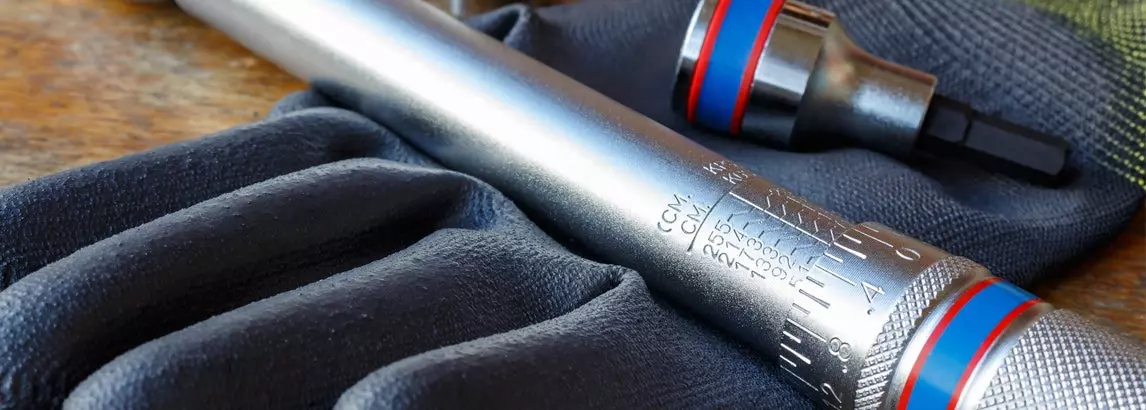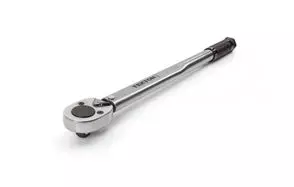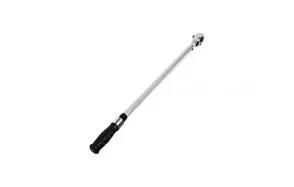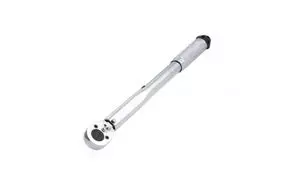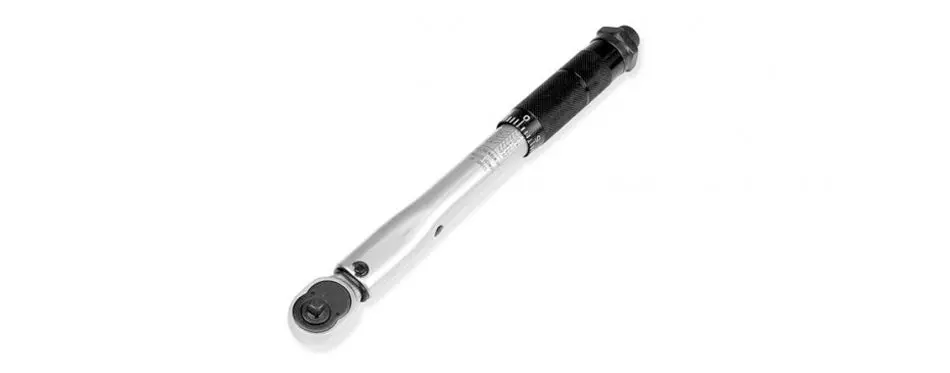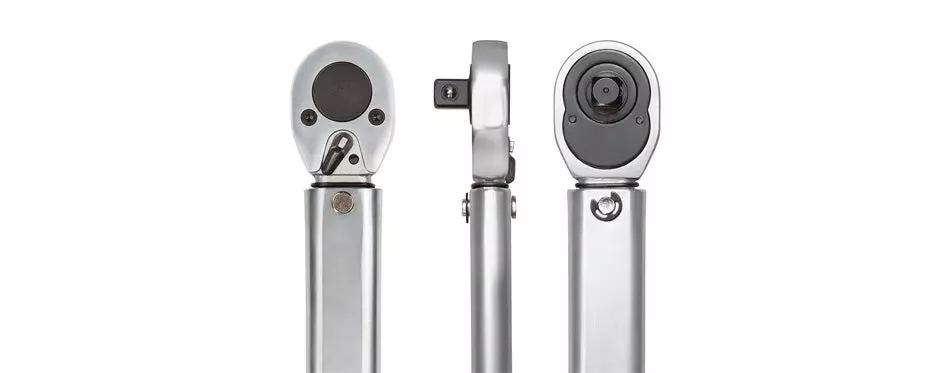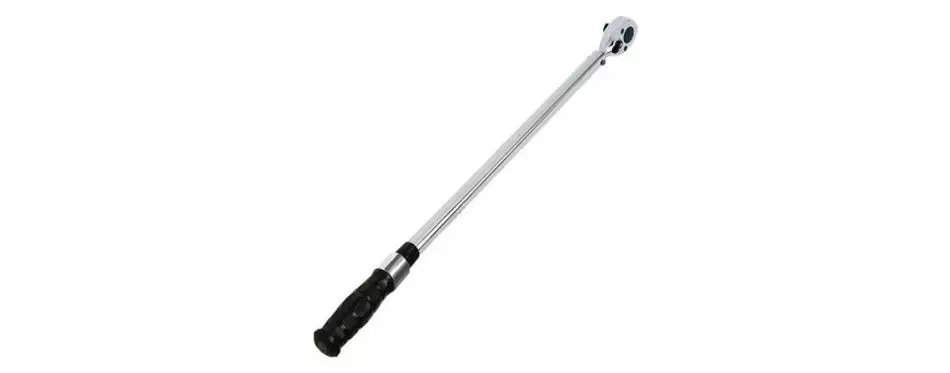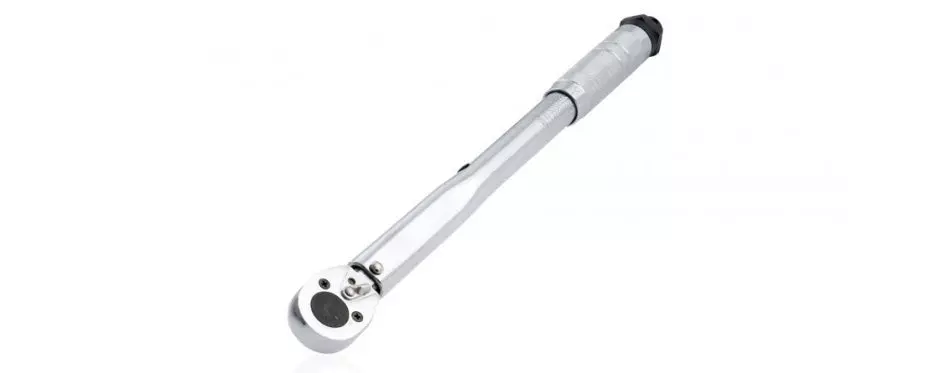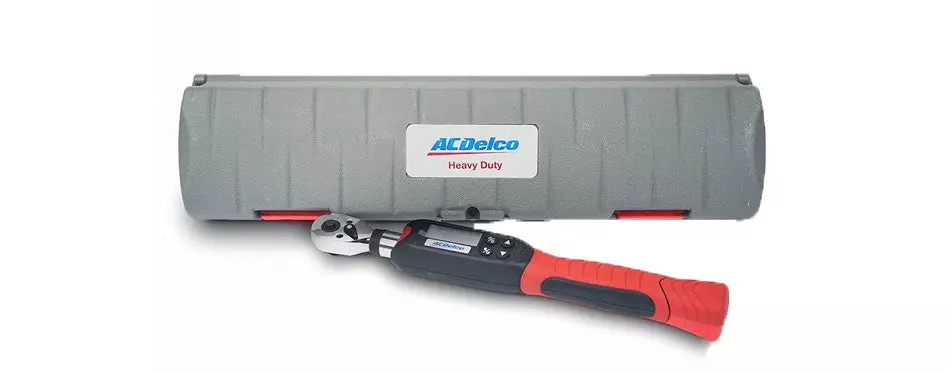- 1. TEKTON 24335 ½ Inch Drive Click Torque Wrench
- 2. TEKTON 24340 ½ Inch Drive Click Torque Wrench
- 3. Precision Instruments PREC3FR250F 1/2 Inch Torque Wrench
- 4. EPAuto ¼ Inch Drive Click Torque Wrench
- 5. Industrial Brand CDI 2503MFRPH 1/2 Inch
- 6. Neiko Drive Adjustable Click Torque Wrench
- 7. Park Tool TW 5.2 Ratcheting Click Type Torque Wrench
- 8. ACDelco ARM601-4 1.2 Inch Digital Torque Wrench
A torque wrench is key part of the toolkit of the serious at home mechanic. It allows you to tighten nuts and bolts to a set and accurate torque. This means they can be tightened sufficiently to avoid loosening whilst the car, truck or machinery is operating.
They also protect nut and bolts from being accidently over tightened which can damage the threading on these key components, lessening their lifespan and making a sudden loosening or failure more likely. Not bad for one little wrench, which is why there are so many makes and models out there on the market right now. Luckily we’re here to help you choose the right one.
The Best Torque Wrench
If you are looking for a great all around torque wrench, this could be your purchase. It has a torque range suitable for use across multiple applications – so you can use this tool on your car brakes, you can use it on your kids mountains bike and you can use it on your lawnmower.
It has a solid, all steel construction that is going to stand up to a lot – and we mean a lot – of use. The head is reversible, meaning it can be used to tighten in either direction and the wrench itself is not huge, making it easy to manipulate on smaller items and in tight spaces.
A great, all round but non-specialist wrench to keep in any handyman’s tool kit.
- All Metal Construction
- Audible “Click” System
- Wide Range of Applications
- Brand TEKTON
- Model 24335
- Weight 2.2 Pounds
This tool is the big brother of the one we discussed above. If you were worried that a Torque range of just 10 to 150 ft. – lb (Foot Pounds) didn’t quite sound like it would be enough for your needs, the 24340 may be for you instead.
It boasts all the plus points of the 24335 model, whilst packing a torque force of between 25 to 250 ft. – lb, a huge increase!
This is all packed into a tool that is only about an inch longer (and 2 pounds heavier), making the 24340 model just as easy to use and manipulate in tight spaces.
A great tool that packs a lot of power.
- All Metal Construction
- Audible “Click” System
- Wide Range of Applications
- Brand TEKTON
- Model 24340
- Weight 4.4 Pounds
This is an excellent entry-level wrench. As you will notice, it has no clicker style head; instead it issues a single audible click when the desired torque force has been achieved.
The torque level itself is set with a simple button on the handle. This wrench is simplicity personified, simply set the appropriate level and tighten your bolt until the tool clicks. Done.
Simple, effective and reasonably priced this is a great starter tool.
- Nickel and Chrome Finish
- Long Term Accuracy
- Certified Accurate to Within 4%
- Brand Precision Instruments
- Model PREC3FR250F
- Weight 4.5 Pounds
If you are not sure that you will be using your torque wrench frequently, you may be tempted to buy a budget model to simply hold in reserve for occasional use.
There is nothing wrong with that of course, and if that is your plan of action it is harder to recommend a better budget wrench than this model from EPAUTO. This is one of the cheapest tools on the market but you get a lot of bang for your buck!
4% accuracy out the box, a hardened ratchet head will give a long lifespan, the range scale is both easy to set and to read and you get an excellent force range of 20 to 200 ft.-lbs, so when you do take this out you know it will be able to easily step up to most jobs.
- Ratchet Head made of Hardened Steel Alloy
- Easy Storage
- Simple to Read Range Scale
- Brand EPAUTO
- Model ST-013-01
- Weight 1.75 Pounds
There is a secret to this wrench, and that secret is that it is actually a Snap-On product, sold under a different name (the company CDI is a subsidiary owned by Snap-On, the high quality California based tool maker).
This means you get a great quality tool at a far lower price than you would expect to pay for it. The scale is very to read and the spring-loaded lock could not be faster or simpler to set.
This is a great tool to keep on hand during protracted jobs where different torques forces are required, as resetting is so simple. This is an excellent, solid tool that will last a long time for a far lower price than the exact same model with a different brand name.
- Solid Construction
- Spring Loaded Pull Down Lock for Fast and Easy Use
- Simple to Read Laser Marked Scale
- Brand Industrial Brand
- Model 2503MFRPH
- Weight 4.3 Pounds
If we were asked to recommend a torque wrench for occasional or even just emergency use, then this would be this model for a number of reasons.
Firstly, it’s incredibly cheap. You can buy this, use it once only and it will still be a bargain!
Secondly, it is so simple to use. One twist unlocks the tool, the handle is then rotated to the desired force and a second twist locks it. This means it’s ideal to keep in the trunk or garage for emergency wheel changes when you want a tool that’s just going to do it’s job, no questions asked.
- 4% Accuracy
- Spring Loaded Pull Down Lock for Fast and Easy Use
- Simple Torque Adjustments
- Brand Neiko
- Model 03713A
- Weight 2 Pounds
Of course, not all wrenches are required to perform high torque functions – sometimes you need something with a little more finesse.
The Park TW.52 is that model. It’s torque range is measured on the Newton Measure scale of Inch Pounds. This scale is used to better reflect the accuracy of the torque setting increments that this tool comes with – torque can be increased or decreased at increments of just 0.4nm.
This makes this tool ideal for smaller, more fragile nuts and bolts than you would typically find on a vehicle – for example, if you have a bike, especially one like a road-racing bike with very delicate components this is the wrench to use to keep all those nuts and bolts safe.
At just nine inches long and 1 pound in weight, it is incredibly easy to use too. This tool is intuitive and carefully calibrated, making it perfect for all those smaller jobs.
- 4% Accuracy
- Range 18 to 124 Inch Pounds
- Small Torque Adjustment Increments
- Brand Park Tool
- Model TW 5.2
- Weight 1 Pound
When it comes to digital models, you are really judging them on two primary functions – simplicity and accuracy.
This wrench, we are happy to report, has both. First simplicity. As a digital model you simple enter the torque force required, place the head over the bolt and tighten until you hear a loud buzz – job done.
Accuracy wise this tool comes with the standard 4% accuracy but the display can also be changed to show read outs in a variety of scales – Foot Pounds, Newton Measurements, Inch Pounds and Kilogram Centimeters. This makes it incredibly easy to calibrate to whatever torque is recommended for whatever you are working on – just press a couple of buttons and away you go.
The price is pretty low too for a digital style model, quite a few dollars below a mid-range, traditional click and twist model. For the price and functionality, this is probably the best model we have seen.
- Large LCD Screen
- 4 to 99 ft-lbs torque range
- Adjustable Display
- Brand ACDelco
- Model ARM601-4
- Weight 4 Pound
Torque Wrench Buying Guide & FAQ
Torque wrenches can be something of an overlooked tool to the home mechanic, but this is a shame because they can bring a number of advantages.
Part of this may be that until recently, they were pretty much considered to be a pro mechanics tool, something that would only be used in a professional vehicle shop.
Luckily, those days are far in the past and there is now a range of excellent wrenches on the market deigned for domestic rather than pro shop use.
Naturally enough, some people still have a few questions about these extremely handy tools, questions such as:
Frankly there two reasons to buy a torque wrench – safety and longevity of parts. By allowing you to select the torque, these tools allow a degree of accuracy when it comes to tightening nuts and bolts.
That may not seem important when you are repairing the broken lock on your glove box – but it is of supreme importance when it comes to the nuts that hold the wheels on, that keep the braking system intact and hold the handlebars of your Childs bike.
With a regular wrench you have to tighten by eye – effectively guess at the correct torque force to tighten to. Most people overestimate to be safe – fair enough. But by using too much force over and over again, the threading on the bolt will be damaged over time, requiring replacement or even failing completely at the worst possible time.
These tools are precision instruments, and will typically come certified that the readings they give will have a margin of error of 4% or less.
Professionals consider that if this goes over 5% the tool will require calibration, so you don’t get much margin for error!
The general rule of thumb is that a calibration should take place roughly after every 3,000 repetitions if you use it regularly, or about every 6 months if the tool only gets occasional use.
Yes and no – sorry, that’s not very helpful, is it?
As you can see from our product guide above, these tools come in a range of force strengths, different sizes, materials and costs.
Generally, it is advisable to buy one wrench that you feel will be able to tackle the bulk of jobs – so this could be working on your truck, car or SUV, tightening things like the lawnmower and other applications around the house. A model with a wide range of torque would be good for this.
If you have bicycles or other items with more delicate components, it could be an idea to buy a wrench with smaller force increments so you can tighten with more care and precision.
Factors to Consider When Buying a Torque Wrench
Due to the various types, sizes and materials that these tools can be made of, there are a number of factors to bear in mind when deciding which tool (or tools!) will be the right one for you.
Just remember these as you consider the various options out there on the market and they will help you make the right decision.
- Accuracy – The whole point of buying this tool is to take advantage of the measurements it can give you during operation. Therefore, it pays to get a model with decent accuracy – otherwise, if the accuracy is poor you might as well save your money and buy a regular wrench!
- Certificates – Carrying on the theme of accuracy, the better models will usually come with a certificate proving the calibration and accuracy of the model that you have purchased. They should also come with instructions on how (and when) to calibrate the tool to keep it accurate.
- Materials – Cheaper models will typically have more elements made of plastic instead of metal. Obviously, this keeps the price down, but plastic, as anyone knows, is not the most long lasting material. You’ll notice that the models we have selected above keep plastic parts to a minimum – even the cheaper models. Buying a tool with most – or all – of the construction in metal should result in a far longer lasting tool that will give better value for money.
- Ratcheting – A wrench with the ability to ratchet is a far more useful tool than one that does not. Most of these tools – and all of the ones we recommend above – come with this ability. It just makes them quicker and easier to use.
- Hard Case – Storage is a bit more of a factor with these tools than with any others because they are calibrated devices. Being banged around in a big toolbox can throw off the calibration and lower the accuracy of the tool. The best way to store this tool is in a hard plastic case, which many of them come with, but it’s worth double-checking before buying. A good case can add years to the lifespan of these tools.
- Scale Readability – Each model has a slightly different way of showing the torque being used and/or setting the torque to be reached. As this is the key feature of this type of tool, it’s worth getting one that can be easily read and used. Of course, the LCD screens on digital wrenches are by far the easiest to use and read. That being said, there are a number of excellent analogue dial style readouts on more traditional models that can also be very easy to use – it’s a personal preference really!
- Handling – finally, just take a look at the handle of the wrenches and try to imagine using them with your hands covered in oil or brake fluid. A tool with a rubberized or plastic handle, or a metal one with nice deep ridges cut will be better to handle – and less slippery. Some models even boast ergonomic handgrips, if you know that you have less trouble effectively gripping a tool during work.
Types of Torque Wrench
There are actually three types of torque wrench on the market, Click –Type, Electronic and Beam.
You will notice that none of the tools we have selected above for our product guide are of the beam type. These are the oldest and most simple type and frankly, they have been pretty much replaced in common use by the other two more modern models.
Beam types are usually very heavy, they are difficult to use and not particularly accurate. The only real advantage they have is that they are usually pretty cheap, but since we found some excellent, modern click style wrenches that are not exactly going to break the bank, even this advantage seems less and less important.
Related Posts: Best Oil Filter Wrenches, Best Lug Wrenches, Best Air Impact Wrenches and Best Cordless Impact Wrench
Click Type
Lovely and straight forward! Set the required torque, apply the wrench head and twist until you hear a click. That little noise indicates that you’ve tightened the bolt to the force you set.
There are a number of advantages to this type, mainly though that it’ so simple straightforward to use. This translates to a typically long lifespan (less parts to break down) and a can usually mean a lower purchase price.
It’s also very helpful that it works by making a noise. This means that you can operate the tool out of direct line of sight – handy for when you are elbow deep in the bowels of a car!
It also needs the occasional calibration, but other than that will sit happily in it’s storage box for months between uses, making it a perfect occasional or even emergency use tool that won’t let you down.
Electronic (or Digital) Type
These models work on the same principle as the click type, except that they have an embedded LCD screen and a little built in speaker. So they will make a noise, usually a buzz like sound, when the set torque has been reached.
In addition however, the screen can give useful feedback on exactly what torque is being applied at any time, meaning you don’t have to rely on listening out. This means that you can incrementally increase the pressure slowly, making digital models perfect to use on more fragile bolts.
The downside of course is that they are almost always more expensive than their equivalent Click style brothers.
It would probably be a good idea to consider a Click style for more heavy duty use such as cars and vehicles, and a digital model for items that require more care such as garden tools and bikes.
Tips on Using a Torque Wrench
- Never use a torque wrench to undo a bolt – they should only be used to tighten them. The risk is that if the bolt is tight, you could accidently apply more torque than the tool can handle safely.
- Always unwind the wrench when you are finished with it. This basically resets the inner workings that are essentially a big spring. Storing it unwound will release the pressure on the spring, helping it to have a longer lifespan.
- Build up pressure smoothly and steadily until you hear that all-important click.
- Each model has a rating for the torque force it can safely handle. Try to avoid going within 25% of the maximum end of that range too often. This will place strain on the inner workings of the wrench; potentially lessening it’s lifespan.
- Most tools come with a marked loading point. This is the point you should hold the tool and apply pressure. The tool will be calibrated for the pressure it will receive when used with your hand at that set angle. Hold and use the tool from this point (or as close as you an get) to ensure an accurate reading.
Sources:
- How do you read a torque wrench? – HowStuffWorks
- How to Reverse Ratcheting Wrenches – Hunker
